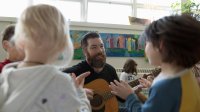Singing as a Tool to Facilitate Transitions
Music can be a great way to engage elementary students in routine tasks like moving from one activity to another.
Your content has been saved!
Go to My Saved Content.Transitions are, by their nature, challenging for young kids. Whether it’s a big change—making a new friend or changing grades—or something much smaller, like lining up at the end of recess, a transitional time inherently creates weak points.
Elementary teachers know that the foundations of classroom management are routines, clear expectations, and a strong and safe community. But changes are hard for kids, even when they’ve been rehearsed ad nauseam, and systems break down. Something as superficially simple as “Move from your desks to the carpet” or “We’re shifting from writing to math” can feel like a landmine.
As a first-grade teacher, I have grown keenly aware of the myriad ways that things can break down when those changes aren’t named, scaffolded, supported, and practiced. If kids haven’t been thoughtfully prepared to learn deeply and play well, they often won’t.
One rocky day, I grabbed my guitar out of frustration and just started singing instructions to a class of wiggly kids. It worked so well and so immediately that I realized that music could be used for more than singing for pleasure or as an instructional tool. It could help kids make sense of their surroundings. A sense of calm fell over the kids as the guitar strings rang out; we were not only following directions but doing so with a tranquillity that can be hard to come by in the midst of a busy day.
Creating Transitions
Regular transitions need to be personal and relatable, for both the students and the teacher. Music and poetry can be a useful way to transition.
Use a song for each action of a transition: Connecting an action to a lyric helps students stay on task. We use a 10-Second Song to name an action for each second of a transition. We use a countdown to help stay focused, singing, “I got 2 more seconds, I’m looking around / 1 more second to calm myself down.”
Reinforce the purpose of an activity: The Cleanup Song describes not only the steps of cleaning up but also the purpose. “Pick up things off the floor / even if they’re not yours / no, this room ain’t gonna clean itself.” Our mantra for entering the classroom is intentionally simple and direct: “Enter the room, but wait your turn / ready to listen, ready to learn.”
Vary the types of transition: One doesn’t need to be a songwriter or a poet to make transitions more fun. For me, the key has been tapping into things that the students and I all love: music, poetry, and wordplay. But a transitional theme could be dancing, stories, recorded music, rhythms, call-and-response, or any number of other methods of engaging the kids’ minds and bodies at the same time. What makes transitions work is a combination of authenticity, routine, student engagement, and a clear purpose.
Create a sense of community: Kids are naturally drawn to music and rhymes, and the communal joy of singing while we work together toward something is usually enough to persuade any holdouts to join us. Whenever we add a name to the word wall, we sing a special song.
Engage children in the creation of the music: When students themselves help craft the songs and poems, they are invested in the transition. At a time when there was a lot of arguing about being first in line, one student suggested the lyrics, “It don’t matter who's first in line / we’re gonna get there at the same time.” Because the songs have specific, explicit, and frequently quirky directions, the communal feel of singing helps them not only to get to where they are going safely and quickly, but to do so with a smile on their face.
Understand the Use
Using music to make transitions more fun and effective is not a panacea. Like anything we expect of kids, it doesn’t always work; sometimes I’m halfway through a line-up song, and the next thing I know, I’m suddenly trying to mediate an argument while trying not to whack kids in the head with the banjo that’s strapped to my chest. At other times, the mood isn’t right for a song; and then there are just those days when even music doesn’t work.
When young kids line up, clean up, or simply move from one activity to another, the thin veneer of orderly behavior is threatened by a single stray fart, a loud sneeze, or a spider someone spots on the ceiling. But when we sing our way through the changes, we’re all on the same page, and it adds a note of whimsy to what is, for some kids, a deceptively challenging expectation.
